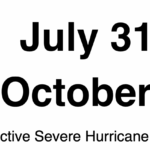Overview of the 2024 Hurricane Season
As the 2024 Atlantic hurricane season approaches its conclusion, it is essential to assess the predictions made at the beginning of the season against the actual outcomes. The National Oceanic and Atmospheric Administration (NOAA) forecasted an above-normal season with an 85% probability, anticipating between 17 to 25 named storms, 8 to 13 hurricanes, and 4 to 7 major hurricanes. This prediction was influenced by several factors, including warmer ocean temperatures and evolving La Niña conditions in the Pacific, which typically enhance hurricane activity in the Atlantic.
Predictions versus Outcomes
So far in the 2024 season, there have been 18 named storms, with 11 developing into hurricanes and 5 reaching major hurricane status. This aligns closely with NOAA’s predictions, indicating that the season has indeed been more active than average. The strongest storm of the season, Hurricane Milton, achieved maximum sustained winds of 180 mph, highlighting the intensity of this year’s storms. The total damage from these hurricanes is estimated to exceed $191 billion, marking it as one of the costliest seasons on record.
Hurricane Helene: Impact and Recovery Efforts
One of the most significant events of this season was Hurricane Helene, which made landfall in late September as a Category 4 hurricane. Its effects were devastating, particularly in Appalachia where it caused unprecedented flooding. The storm dumped record rainfall across western North Carolina and eastern Tennessee, leading to catastrophic flooding that resulted in over 200 fatalities and extensive damage to infrastructure.The flooding was exacerbated by the region’s topography and previous environmental degradation due to logging and mining activities. In total, more than 34 new flood records were set across Appalachia as rivers overflowed their banks, washing away homes and disrupting lives. Recovery efforts are ongoing, with local organizations and state agencies working tirelessly to restore affected communities. For instance, East Tennessee State University (ETSU) has utilized drone technology to assess damage and aid in relief efforts.
Machine Learning and Computer Vision in Disaster Response
In the wake of disasters like Hurricane Helene, Artificial Intelligence ( a.k.a Machine Learning and Computer Vision ) can play a pivotal role in assessing damage and facilitating recovery efforts. Fluids.ai has expertise and experience to do all of these tasks. AI models can analyze aerial imagery captured by drones or satellites to identify affected areas quickly and accurately.Key applications include:
- Damage Assessment: Computer Vision can process images to detect structural damage to buildings and infrastructure, allowing for prioritized response efforts.
- Flood Mapping: Computer Vision techniques can help create detailed flood maps post-disaster, identifying areas most at risk for future events.
- Resource Allocation: By analyzing data on affected populations and infrastructure damage, Machine Learning can assist emergency management teams in efficiently allocating resources for recovery.
- Predictive Modeling: Machine learning models can analyze historical data to forecast future storm impacts based on current climatic conditions, aiding in better preparedness strategies.
The integration of these technologies not only enhances immediate response capabilities but also supports long-term rehabilitation efforts by informing infrastructure improvements and community resilience planning.
Conclusion
The 2024 hurricane season has been marked by significant storm activity and devastating impacts from Hurricane Helene. As communities work towards recovery, leveraging advanced technologies such as machine learning and computer vision will be crucial in assessing damage and improving future disaster response strategies. Continued investment in these areas will be essential for enhancing resilience against increasingly severe weather events driven by climate change.
References :











